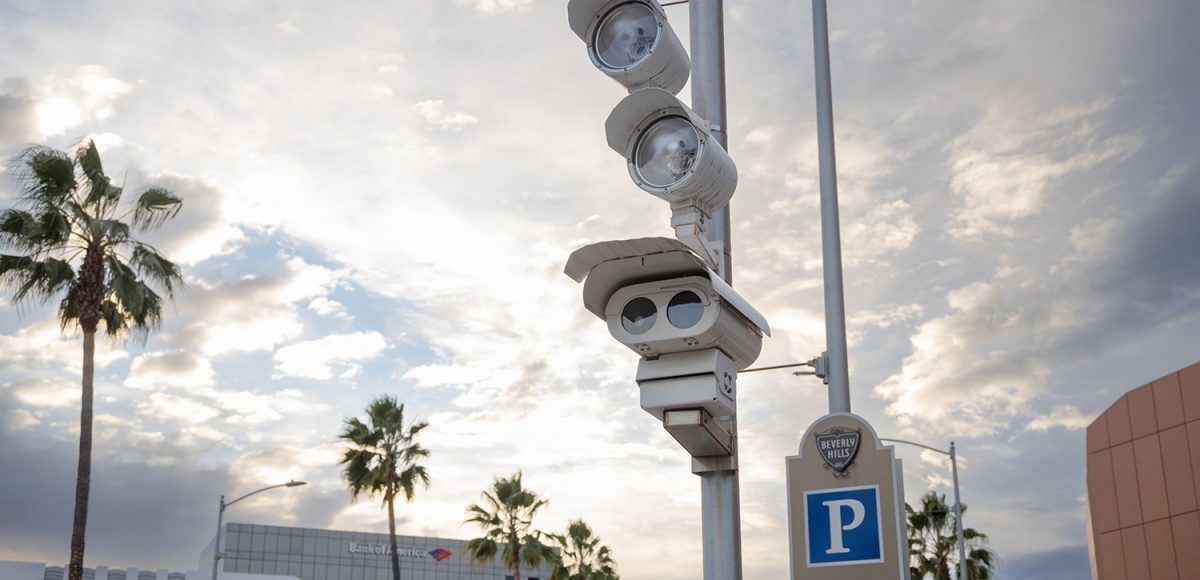The Beverly Hills City Council took up the topic of the city’s extensive CCTV (closed-circuit television) camera system during its Feb. 8 Regular Session. The agenda item put forth by Vice Mayor Lili Bosse was directed at the expansion of coverage into residential alleyways. The discussion included a presentation by Beverly Hills Police Department (BHPD) Chief Mark Stainbrook. Although no official vote was taken, the Council acknowledged the important role the cameras play in overall public safety.
The CCTV cameras were installed beginning in 2005 with a 20-year roadmap that would result in over 1,000 cameras in areas across Beverly Hills. Seventeen years later, more than 2,000 cameras watch over the city in what Councilmember John Mirisch referred to as a “virtual wall.”
CCTV cameras monitor nearly every intersection in the business triangle. The BHPD also utilizes mobile trailers equipped with cameras that can be placed in problematic areas and has recently undertaken an aerial drone pilot program.
In the future, Stainbrook said, the system could also benefit from the use of private security cameras and partnerships with residential camera companies like Ring and Nest.
Stainbrook gave a brief report on recent crimes in alleyways, which found that although crimes there are still prevalent, the numbers are trending down. To deter more crime in those areas, BHPD has moved to place more armed security guards and police patrols in alleyways that have seen repeated crimes or have become dwelling areas.
The Council discussed the fact that alleyways, particularly in locations used by unhoused individuals, are a priority for more camera coverage and extra foot and vehicle patrols. Bosse cited an incident of antisemitic tagging in a residential alleyway last week. The Council briefly weighed in on how to protect unhoused individuals who are not committing crimes in those areas.
“We’re working right now to bring mental health experts into the police department and ride with our officers,” Stainbrook said. “We’re actively engaged in that project.”
“If we know a location is problematic, and we’re trying to figure out why, we can put up temporary cameras in areas where we don’t have coverage,” Stainbrook said.
Stainbrook elaborated on the use of drones in high-crime areas, which he says has been successful. He cited an incident earlier this year when an individual who stole a Rolex watch in the San Fernando Valley was caught on license plate recognition cameras in Beverly Hills. An arrest was made after aerial drones and ground units convened on the suspect.
An arrest was also made using the drones on Jan. 23 when a petty theft suspect hid at the top of a parking structure.
“We’ve had a few really good cases solved in just the last few weeks with that integrated approach,” Stainbrook said.
Councilmembers expressed interest in the possibility of introducing artificial intelligence into the camera system as a way to monitor footage and prevent crime.
“It would take a lot of live operators to monitor 2,000 cameras,” Stainbrook said. “There’s no way to really monitor those cameras without some help from AI.”
Stainbrook said that although there is room for growth, artificial intelligence can help with tasks such as license plate recognition, crowd management, and geofencing.
The Council expressed support for the program and hope that it could expand to offer more coverage throughout the city.
“We never knew that we could enter this period with the pandemic, with all of the related kinds of crimes, with these bad state policies coming from Sacramento,” Mirisch said. “We need all of these tools and more.”







